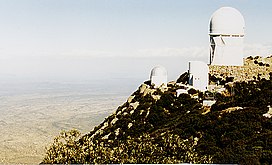|
Altar Valley
The Altar Valley is a 45-mile (72 km) long north–south valley, trending slightly northeast from Sasabe, Arizona on the Mexico border to the Avra Valley west of the Tucson Mountains. It is delimited by Arizona State Route 86, from east-to-west on the north separating it from the Avra Valley which then trends northwesterly, merging into the plains and drainage of the Santa Cruz River. The valley is traversed from north to south by Arizona Route 286. The major Baboquivari sky island range borders the valley on the west; the east is bordered by a series of mountain ranges, that have Nogales, Arizona nestled in between at the United States-Mexico border. Two wilderness areas lie to the west of the valley, the Coyote Mountains Wilderness east of Kitt Peak Observatory, and the Baboquivari Peak Wilderness. The center of the valley is near Baldy Peak (31°50′46″N 111°20′06″W / 31.8462°N 111.3351°W) in the southwest Sierrita Mountains.[1] Baldy Peak's height is 4,120 feet (1,256 m).[2] Madrean Sky IslandsThe Madrean Sky Island region of southeast Arizona, extreme southwest New Mexico, northern Sonora and extreme northwest Chihuahua, Mexico, is the region at the northern limits of the western spine mountain of Mexico, the Sierra Madre Occidental-(Mother Mountains, West). The ranges were broken up by Basin and Range faulting, and leaving wide areas of bajadas or graben-type valleys, sometimes with obvious horst-type mountain ranges; even extreme volcanic cones can form on these horst boundaries, like the seven minor volcanoes at the northern end of the Mohawk Mountains Buenos Aires National Wildlife RefugeThe Buenos Aires National Wildlife Refuge borders the southeast Altar Valley and covers half the valley's length. Sasabe, the U.S.-Mexico border town is surrounded by the refuge, including to the west. The lower elevation Cerro Colorado range borders the refuge to the northeast, the similar San Luis Mountains to the southeast. Table of mountain rangesThe mountains to the west and east associated with the Altar Valley. On maps of Arizona, in the Altar Valley region, the United States-Mexico border changes direction to the northwest to end at the Colorado River at Yuma, Arizona. This change in border direction mostly follows a water divide change, separating drainage basins from each country; there are minor regional exceptions along the border to Yuma and the California border. Southern Arizona's desert waters flow north-northwest mostly ultimately ending at the Gila River which starts in extreme southwestern New Mexico and ends at Yuma, bordering California. Mexico's border drainage is into the Gran Desierto de Altar, with two rivers of northern Sonora draining to the southwest into the northern Gulf of California. These two areas of southwest Arizona and northwest Sorona are most inhospitable and dangerous in summer months. (The Barry M. Goldwater Air Force Range uses the Arizona region because of its remoteness and yeartime usage abilities by flight.)
References
External linksWikimedia Commons has media related to Altar Valley. Wikivoyage has a travel guide for Altar Valley. Buenos Aires National Wildlife Refuge Baldy Peak |
||||||||||||||||||||||||||||||||||||||||||||||||||||||||||||||||

